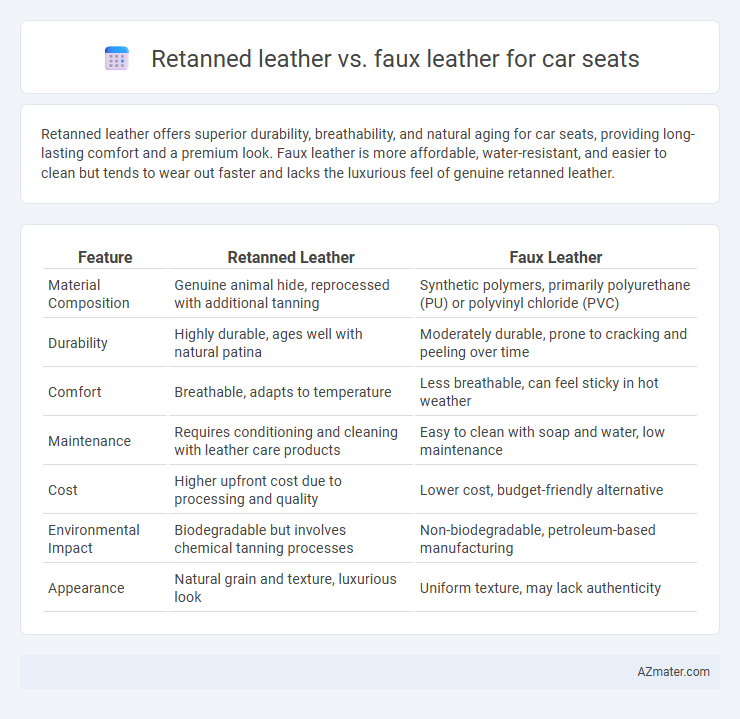Retanned leather offers superior durability, breathability, and natural aging for car seats, providing long-lasting comfort and a premium look. Faux leather is more affordable, water-resistant, and easier to clean but tends to wear out faster and lacks the luxurious feel of genuine retanned leather.
Table of Comparison
| Feature | Retanned Leather | Faux Leather |
|---|---|---|
| Material Composition | Genuine animal hide, reprocessed with additional tanning | Synthetic polymers, primarily polyurethane (PU) or polyvinyl chloride (PVC) |
| Durability | Highly durable, ages well with natural patina | Moderately durable, prone to cracking and peeling over time |
| Comfort | Breathable, adapts to temperature | Less breathable, can feel sticky in hot weather |
| Maintenance | Requires conditioning and cleaning with leather care products | Easy to clean with soap and water, low maintenance |
| Cost | Higher upfront cost due to processing and quality | Lower cost, budget-friendly alternative |
| Environmental Impact | Biodegradable but involves chemical tanning processes | Non-biodegradable, petroleum-based manufacturing |
| Appearance | Natural grain and texture, luxurious look | Uniform texture, may lack authenticity |
Introduction to Retanned and Faux Leather
Retanned leather undergoes an additional tanning process using natural oils or synthetic agents, enhancing durability, flexibility, and water resistance, making it ideal for premium car seats. Faux leather, typically made from polyurethane or polyvinyl chloride (PVC), offers a cost-effective, animal-friendly alternative with easy maintenance and diverse color options. Both materials provide distinct advantages in texture, longevity, and environmental impact, influencing consumer choice in automotive upholstery.
Key Characteristics of Retanned Leather
Retanned leather for car seats undergoes a secondary tanning process that enhances durability, water resistance, and softness, making it more resilient to wear and tear compared to standard leather. It retains natural breathability and develops a unique patina over time, offering both comfort and aesthetic appeal. In contrast, faux leather lacks the natural grain and aging properties, often resulting in less durability and breathability.
Defining Faux Leather: Features and Types
Faux leather, a synthetic alternative to genuine leather, is commonly used for car seats due to its durability, affordability, and ease of maintenance. It includes various types such as polyurethane (PU) leather and polyvinyl chloride (PVC) leather, each offering different levels of softness, breathability, and resistance to wear. These materials mimic the texture and appearance of natural leather while providing enhanced water resistance and color retention, making them ideal for automotive upholstery.
Durability: Retanned Leather vs Faux Leather
Retanned leather offers superior durability for car seats due to its natural fiber structure and enhanced tanning process, which increases resistance to wear, cracking, and aging over time. Faux leather, made from synthetic materials like polyurethane, provides decent durability but typically deteriorates faster under constant exposure to heat, friction, and UV rays. Choosing retanned leather ensures longer-lasting comfort and aesthetic appeal in automotive upholstery compared to the more prone-to-oxidation faux leather.
Comfort and Feel for Car Seat Applications
Retanned leather offers superior breathability and natural softness, enhancing comfort during long drives by adapting to body temperature and reducing sweat buildup in car seat applications. Faux leather, while more affordable and resistant to stains, often lacks the supple texture and breathability that genuine retanned leather provides, potentially causing discomfort in warmer conditions. The tactile experience of retanned leather closely mimics natural hide, providing a premium feel preferred by luxury car owners seeking both durability and comfort.
Aesthetic Appeal and Customization Options
Retanned leather offers a rich, natural texture with a unique patina that enhances the aesthetic appeal of car seats, providing a luxurious and classic look that improves over time. Faux leather, available in a wider range of colors and finishes, supports greater customization options, allowing for tailored aesthetics and easier maintenance while mimicking the appearance of genuine leather. Choosing between retanned leather and faux leather depends on preferences for authentic aging beauty versus versatility in design and color choices.
Maintenance and Cleaning Requirements
Retanned leather car seats require regular conditioning and gentle cleaning with specialized leather cleaners to maintain their suppleness and prevent cracking. Faux leather seats need only mild soap and water for cleaning, resisting stains and spills better but are prone to cracking over time due to lack of natural oils. Both materials benefit from avoiding prolonged sun exposure, with retanned leather demanding more attentive upkeep to preserve its natural texture and durability.
Environmental Impact and Sustainability
Retanned leather, derived from animal hides processed with eco-friendly tanning agents, offers a more biodegradable and durable option compared to synthetic materials. Faux leather, typically made from polyvinyl chloride (PVC) or polyurethane (PU), involves petroleum-based production that contributes to higher carbon emissions and non-biodegradability. Choosing retanned leather reduces reliance on fossil fuels and minimizes microplastic pollution, supporting sustainability in automotive upholstery.
Cost Comparison: Investment and Longevity
Retanned leather offers a higher initial investment due to its complex tanning process and durability, making it a premium choice for car seats. Faux leather presents a lower upfront cost but typically requires more frequent replacement, reducing its cost-effectiveness over time. Considering longevity, retanned leather retains aesthetic appeal and structural integrity significantly longer, justifying its greater expense through extended use.
Conclusion: Choosing the Best Material for Your Car Seats
Retanned leather offers superior durability, breathability, and a natural feel, making it ideal for car seats requiring long-lasting comfort and premium appearance. Faux leather provides affordable, low-maintenance, and water-resistant options, suitable for budget-conscious users or those seeking easy cleaning. Selecting the best material depends on prioritizing either luxury and longevity with retanned leather or cost efficiency and practicality with faux leather.

Infographic: Retanned leather vs Faux leather for Car seat
 azmater.com
azmater.com